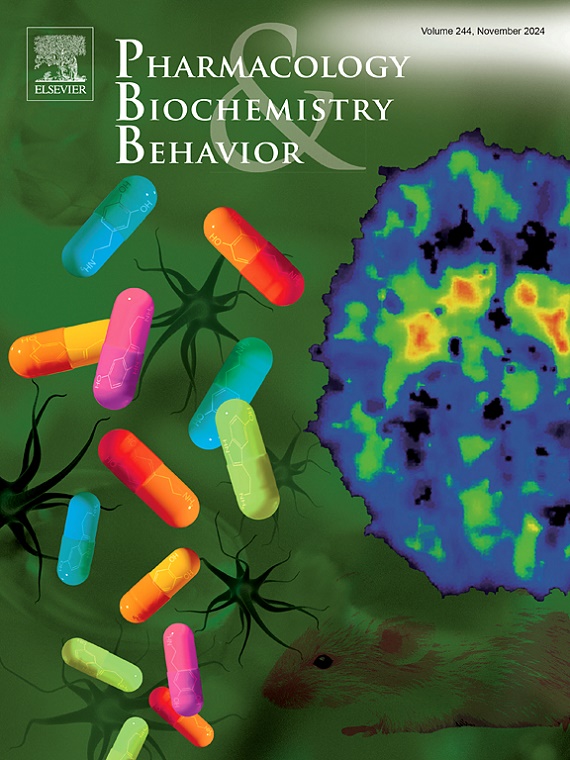Population-dependent impacts of para-chlorophenylalanine, a tryptophan hydroxylase inhibitor, on homebase formation and thigmotaxis in adult zebrafish
IF 3.3
3区 心理学
Q1 BEHAVIORAL SCIENCES
引用次数: 0
Abstract
Alterations in monoamine levels, such as serotonin, play a role in the pathophysiology of affective disorders. Para-chlorophenylalanine (pCPA), a tryptophan hydroxylase inhibitor, impairs serotonin synthesis and increases anxiety-like behaviors in various species. Outbred zebrafish population, such as short fin (SF) and leopard (LEO), differ in serotonin expression, habituation patterns, and responses to novel environments. Locomotor and exploratory profiles are strongly influenced by homebase behavior, which can be assessed in the open field test (OFT). To further investigate a putative role of the serotoninergic system in homebase formation and exploratory behavior dynamics, we administered pCPA to two zebrafish populations (SF and LEO) with distinct anxiety profiles and homebase occupancy. Fish received intraperitoneal injections of pCPA (300 mg/kg) or vehicle for two consecutive days, followed by a 30-min OFT 24 h later. Both pCPA-treated populations showed increased locomotion and periphery occupancy was elevated during the habituation period (first 15 min of testing). Although pCPA did not alter homebase-related behaviors in LEO, the SF population exhibited a delayed homebase formation, likely due to disrupted exploratory-related mechanisms. Furthermore, Principal Component Analysis (PCA) and K-means clustering revealed that behaviors related to periphery occupancy and distance traveled accounted for approximately 80 % of the observed data variability. Collectively, our data show that pCPA impairs homebase formation, with stronger effects in SF fish and increases thigmotaxis. Overall, these results suggest that pCPA disrupts the organization of exploratory behavior, particularly the habituation processes, probably associated with anxiety-like phenotypes.
对氯苯丙氨酸(一种色氨酸羟化酶抑制剂)对成年斑马鱼母碱形成和吸氧性的种群依赖性影响
单胺水平的改变,如血清素,在情感性障碍的病理生理中起作用。对氯苯丙氨酸(pCPA)是一种色氨酸羟化酶抑制剂,在各种物种中损害血清素合成并增加焦虑样行为。近亲繁殖的斑马鱼种群,如短鳍(SF)和豹纹(LEO),在血清素表达、适应模式和对新环境的反应方面存在差异。本垒行为对运动和探索剖面有很大影响,这可以在野外测试(OFT)中进行评估。为了进一步研究血清素能系统在本垒形成和探索性行为动力学中的作用,我们对两个具有不同焦虑特征和本垒占用的斑马鱼种群(SF和LEO)进行了pCPA治疗。鱼连续两天腹腔注射pCPA (300 mg/kg)或载体,24小时后进行30分钟的OFT。在习惯化期间(测试的前15分钟),两个pppa处理的种群都表现出运动增加和外围占用率升高。尽管pCPA没有改变LEO中与本垒相关的行为,但SF群体表现出本垒形成的延迟,可能是由于探索相关机制的破坏。此外,主成分分析(PCA)和K-means聚类表明,与周边占用和行驶距离相关的行为约占观察到的数据变异性的80%。总的来说,我们的数据表明,pCPA损害了本垒的形成,对SF鱼的影响更大,并增加了移植物性。总的来说,这些结果表明,pCPA破坏了探索行为的组织,特别是习惯化过程,可能与焦虑样表型有关。
本文章由计算机程序翻译,如有差异,请以英文原文为准。
求助全文
约1分钟内获得全文
求助全文
来源期刊
CiteScore
6.40
自引率
2.80%
发文量
122
审稿时长
38 days
期刊介绍:
Pharmacology Biochemistry & Behavior publishes original reports in the areas of pharmacology and biochemistry in which the primary emphasis and theoretical context are behavioral. Contributions may involve clinical, preclinical, or basic research. Purely biochemical or toxicology studies will not be published. Papers describing the behavioral effects of novel drugs in models of psychiatric, neurological and cognitive disorders, and central pain must include a positive control unless the paper is on a disease where such a drug is not available yet. Papers focusing on physiological processes (e.g., peripheral pain mechanisms, body temperature regulation, seizure activity) are not accepted as we would like to retain the focus of Pharmacology Biochemistry & Behavior on behavior and its interaction with the biochemistry and neurochemistry of the central nervous system. Papers describing the effects of plant materials are generally not considered, unless the active ingredients are studied, the extraction method is well described, the doses tested are known, and clear and definite experimental evidence on the mechanism of action of the active ingredients is provided.

 求助内容:
求助内容: 应助结果提醒方式:
应助结果提醒方式:


